It is obvious that it is a good thing for a team to have a great player. Great players make their teams winners. Logically, having a great player on your team should result in more standing points, which will give your team a greater likelihood of making the playoffs and a better seed in the playoffs. To steal a little thunder from the body of this article, that assumption is generally correct.
In this article, I’ll focus on defensemen. Specifically, I’ll focus on the top two defensemen on each team. A team’s top two defensemen may not be a normal defensive pair.
A related article will focus on the top three forwards (Impact of Top Three Forwards).
Study Method
I’ll use Productivity Rating (PR) to identify the top two defensemen on each team in each season. (For more information on PR, see the article Introduction to Productivity Rating.) Defensemen who were traded mid-season will have their season PR-Score proportionally allocated to each team he played for. That is, if Bobby Clobber had a PR-Score of 4.4000 and played 20 games with Detroit and 60 with Seattle, he’d have a PR-Score of 3.3000 for Seattle while his Detroit PR-Score would be 1.1000.
For each team, I will note the PR-Category of their top two defensemen. In 2017, Colorado’s top two defensemen were Erik Johnsson and Tyson Barrie. Both had PR-First5 seasons.
I will also use the points each team gained in the regular season. For example, in 2017 Colorado had 95 points. For the lockout/pandemic shortened seasons, I’ll calculate how many points the team would have had in 82 games. Minnesota had 55 points in 48 games in 2012, which becomes 94 points in 82 games (55*(82/48)).
Putting all the information together for one team in one season: in 2017, Colorado’s top two defensemen had PR-First5 seasons, and the team had 95 points. In total, there are 456 data points (team-season, top two defensemen PR-Categories, standing points).
Top Two Defensemen: An Overview
The top PR category is PR-Elite, and there were obviously teams that had a defenseman who had a PR-Elite season. No team had two defensemen who were PR-Elite. The team that came the closest to having two PR-Elite defensemen was the 2008 Anaheim Ducks with Scott Niedermayer (PR-Elite) and Chris Pronger (PR-Star; just missed being PR-Elite).
The most common top-two combinations were: PR-Star and PR-First5 (167 times); PR-First5 and PR-First5 (139 times). Together they account for two-thirds of the data.
The least common top-two combination was PR-Elite and PR-Regular, occurring three times. The 2015 Pittsburgh Penguins were one of those teams, with Kris Letang and Brian Dumoulin. The other two teams were both Ottawa (2014 and 2015), and both times it was Erik Karlsson and Cody Ceci.
Finally, the lowest combination was PR-Regular and PR-Regular, occurring seven times. These teams’ best defensemen were essentially second-pair defensemen. One exemplar of this combination was the 2017 Detroit Red Wings with Trevor Daley and Jonathan Ericsson.
I’m going to switch to using the PR-Category number (which actually does exist) rather than the text in the tables in this article.
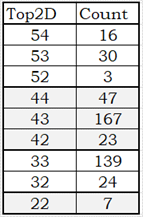
PR-Elite is 5, PR-Star is 4, PR-First5 is 3 and PR-Regular is 2. For completeness’s sake, PR-Fringe is 1 and PR-CallUp is 0. Fortunately, no team had one of their two best defensemen in either of those categories.
This first table shows the distribution of top-two defensemen combinations. As an example, there were 30 teams who’s top two defensemen were PR-Elite and PR-First5 ([53]).
Knowing the distribution of top-two defensemen is interesting, but it isn’t the focus of this study. The question is how valuable the top defensemen are, not how many there are.
A clear picture of value comes from looking at the top defenseman.
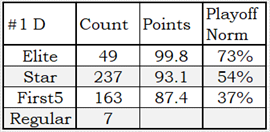
Teams whose top defenseman had a PR-Elite season averaged 99.8 points in the standings. This compares quite favourably to the league average of 91.5 points. These teams hit the “playoff norm”, meaning they had 94 or more points, 73% of the time.
This second table shows that the better your best defenseman is, the more points you’ll have in the standings and the more frequently you’ll make the playoffs. But a PR-Elite performance from a defenseman can drag a team into the playoffs by himself. In 2015, Calgary had Mark Giordano (PR-Elite) and TJ Brodie (PR-First5, just short of PR-Star), and managed to get all of 77 points on the season. Despite the performance of their top two defensemen, the gave up the most goals in the league.
I decided to not show the average points or Playoff Norm percentage for teams whose best defenseman was a PR-Regular because fewer than ten teams were in that state. While the points total was quite low, the playoff norm figure was unexpectedly high. Two of the seven teams made the playoff norm: New Jersey in 2011 had 102 points, Los Angeles in 2021 had 99 points.
This is a problem that can crop up with small sample sizes (small-n problem), and can be demonstrated if you have a regulation deck of cards and a little patience. Shuffle the deck thoroughly, turn over the first seven cards, and count the number of deuces and black aces. Usually, your count will be one or zero. Around 10% of the time, you’ll get two or more.
It is better to not show numbers based on small sample sizes. “Too small to be reliable” means “you shouldn’t show the number”, even when it conforms with expectations.
The focus of this article was to be the impact of a team’s top two defensemen. The following table shows that impact, but requires some intelligent reading.
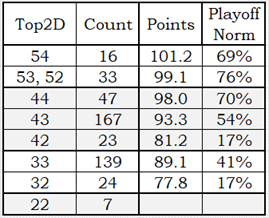
The [53] and [52] defensive pairs were collapsed into one group, as there were only three [52] pairings. The impact of having a good defensive pair is told in the Points column: better defensemen mean more points.
The 69% figure for [54] teams is caused by a couple of teams that had unusually good defensemen and unusually poor team results: Philadelphia got 88 points in 2009 with Chris Pronger and Kimmo Timonen; Nashville got 88 points in 2013 with Shea Weber and Roman Josi; Calgary got 84 points in 2017 with Mark Giordano and Dougie Hamilton.
If your top defenseman is a PR-Star, your second-best defenseman matters. If your #2 D is also a PR-Star [44], you make the playoffs 70% of the time. If he’s a PR-First5 [43], you make the playoffs a little more than half the time, while if he’s a PR-Regular [42], you make the playoffs less than one time in five.
If your two best defensemen are PR-First5 [33], you make the playoffs two times in five. If your top two defensemen are PR-First5 and PR-Regular [32], your chances of making the playoffs are one in five.
If your two best defensemen are PR-Regulars [22], your hope is that the small-n inconsistency continues. My guess is that teams like this should make the playoffs no more than 10% of the time.
Results
It is difficult to definitively state the value of the top two defensemen on a team. The problem is: their value compared to what? Every team in the study had two defensemen who could be identified as the team’s top two: from 2008 Tampa Bay (Lukas Krajicek and Andrej Meszaros) to 2021 Colorado (Cale Makar and Devon Toews). I’ll compare defensemen and defensive pairs to the league average (91.5 points per team per season).
Another problem is that hockey being a team game, and the deciding factor for many teams isn’t their top two defensemen, but rather it’s their top three forwards, or their second line or their second defensive pair or their sieve of a goalie. Putting two stud defensemen on a team whose best forwards are three duds will get you nowhere in the standings.
In fact, the team problem is the bigger problem: the success of a team cannot be attributed solely to one player, or to one pair of defensemen, or to a forward line. A team gets about 20,000 minutes of ice time during a season, and a guy who plays a ton of time might get 1,600 minutes per season: that’s only 8% of his team’s ice time.
But I wanted to state the value/impact of defensemen in terms of standing points, and I’m not going to let a couple of problems get in the way! The next table shows how the benefits to a team from their top ranked defenseman.
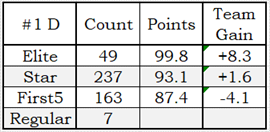
Looking at the top pair of defensemen on a team, it cannot be questioned that the better the players, the better the team.
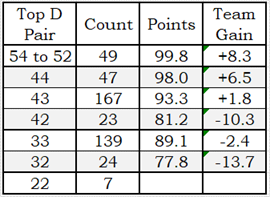
There is a related article: Impact of Top Three Forwards. You should read it, as it has a surprise ending.
